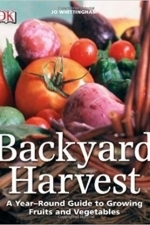Search
Search results
Goddess in the Stacks (553 KP) rated Backyard Harvest in Books
Sep 8, 2017
An indispensable guide for the beginning gardener
Backyard Harvest is set up by months, which makes for a unique and absolutely essential (to me, a beginner) book. In every month, it tells you what you should be eating (provided you had planted it previously!), what you should be planting, what you should be pruning or transplanting or otherwise working on, and usually a few pages on a seasonal-appropriate subject. (A section on apples and apple trees in November, for example.) The layout is gorgeous, the instructions are easy to understand, and I feel like after a few years of following this book I’ll be eating from my garden every month of the year with ease.
For January, for example, if I had these things planted, harvested, or stored from last year, I should be eating pickles, stored root veggies, newly lifted Salsify, forced Belgian Endive, and winter radishes, among other tasty-looking things. I should be sowing (indoors, to transplant after the last frost) early-season leeks, summer onions, lettuce, broad beans, cut-and-come-again greens, and early peas and radishes. For tending, I should be amending my soil, keeping an eye on my stored fruits and veggies for signs of rot, pruning some of my fruit trees, and picking up fallen leaves from hardy winter brassicas so they don’t cause rot at the base of the plants. The feature for the month is building a seedbed, both raised and non. In January I should be harvesting celeriac, early broccoli, the aforementioned Belgian Endive, and spring greens. Another feature for the month is sprouting seeds for use in salads. Each of these categories gets its own two-page spread, the monthly features occasionally getting four or more.
It’s a lovely, really useful book, and one I HAD to own after getting it from the library. It will be getting heavy use in the coming months, I’m sure!
Whittingham has written or co-written three other books – Vegetable Gardening and Grow Vegetables before this book, and Simple Steps to Success: Fruit and Vegetables in Pots after. The latter appears to be a combination of the first two in a new format, but I could be wrong. So I’m not sure I’d recommend any of those three – I haven’t read them – but Backyard Harvest is awesome!
You can find all my reviews at http://goddessinthestacks.wordpress.com
For January, for example, if I had these things planted, harvested, or stored from last year, I should be eating pickles, stored root veggies, newly lifted Salsify, forced Belgian Endive, and winter radishes, among other tasty-looking things. I should be sowing (indoors, to transplant after the last frost) early-season leeks, summer onions, lettuce, broad beans, cut-and-come-again greens, and early peas and radishes. For tending, I should be amending my soil, keeping an eye on my stored fruits and veggies for signs of rot, pruning some of my fruit trees, and picking up fallen leaves from hardy winter brassicas so they don’t cause rot at the base of the plants. The feature for the month is building a seedbed, both raised and non. In January I should be harvesting celeriac, early broccoli, the aforementioned Belgian Endive, and spring greens. Another feature for the month is sprouting seeds for use in salads. Each of these categories gets its own two-page spread, the monthly features occasionally getting four or more.
It’s a lovely, really useful book, and one I HAD to own after getting it from the library. It will be getting heavy use in the coming months, I’m sure!
Whittingham has written or co-written three other books – Vegetable Gardening and Grow Vegetables before this book, and Simple Steps to Success: Fruit and Vegetables in Pots after. The latter appears to be a combination of the first two in a new format, but I could be wrong. So I’m not sure I’d recommend any of those three – I haven’t read them – but Backyard Harvest is awesome!
You can find all my reviews at http://goddessinthestacks.wordpress.com
